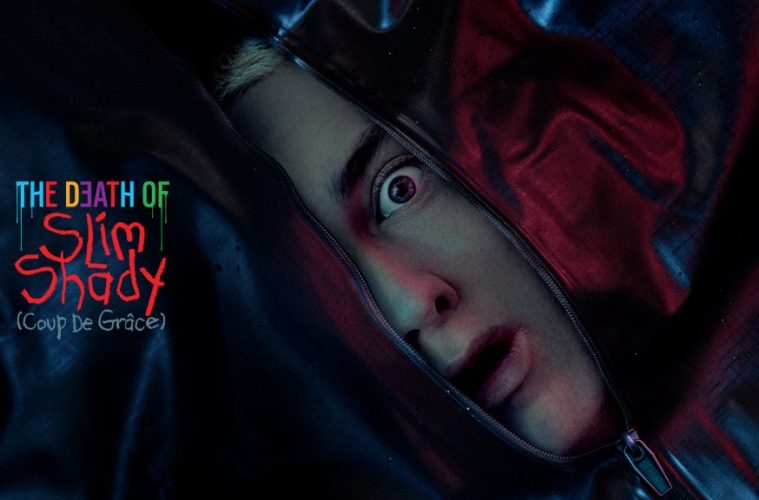Eminem’s place in the hip-hop community has been a hot topic since his first shot out of the gate as he had, and continues to have, a polarizing effect on hip-hop listeners. Back in 2000, his music and image created a surge in blonde hair dye jobs in suburban White boys, from the preppy Abercrombie stock to the music-loving stoner intellects. Some urban-dressing White hip-hop fans would immediately disassociate themselves from Eminem and his music, most likely for fear of ridicule via comparison to both. For Black hip-hop fans, the effect was much more divisive. Some, like me, viewed the lyrical skills as all that mattered. Others viewed him as an intruder in a Black art form who only appeals to White people. The part concerning appeal rings somewhat true as I’ve heard Eminem quoted by White people I knew who to not even like hip-hop: From a middle-aged White co-worker of mine from that time who’d oft-times randomly quote some of Em’s most disturbing lines to my high school guidance counselor who I once witnessed gain control of a group of unruly students by shouting “Will the real Slim Shady please stand up?!”.
His breakthrough debut album, “The Slim Shady LP”, was a tongue-twisting rhymed discourse of self-deprecation and pop culture barbs via the introduction of his Slim Shady persona. However, the over-the-top cartoonish violence of Slim Shady caused many to miss the point of his satire. Eleven albums and twenty-five years later, we arrive at the character’s end with “The Death of Slim Shady (Coup De Grâce)”. It’s evident that his pen game remains sharp, but the aforementioned polarization causes Eminem to also remain as an acquired taste even now: You either like him or you don’t. But, with this album, the Slim Shady persona is in full effect for apparently one last time, taking his customary bitingly humorous aim at celebrities, the mass media, and society’s hypocrisy.
The opening track, “Renaissance” begins with the sound a grave being spat upon and, given Em’s penchant for references, it wouldn’t be surprising if that was a nod to the “Hawk Tuah” girl. Lyrically, he briefly does an inverse of the concept he began on “Stan” and explores the minds of obsessed haters. He attacks the current climate of political correctness on “Habits” and there are several skits showing the dichotomy of the Slim Shady and Eminem halves of his nature while taking shots at cancel culture. “Brand New Dance” sounds reminiscent of 2002’s “Square Dance” may have been left on the cutting room floor Em’s album from that year. The purpose of “Evil” is to spark controversy and appropriately leads into “Lucifer”, which is the only song with Dr. Dre’s hand in the production. As for the beats, the tracklist mostly has Em and Luis Resto credited with multiple producers assigned to tracks, including Emile, FredWreck, Dem Jointz, and Mr. Porter to name a few. “Antichrist” has a playful beat and shows Em’s mastery of wordplay, homophones, and flow, particularly on the third verse:
While Em has been shown to hold down an album on his known, he’s not above collaborations with older and newer school rappers. “Fuel” sees him sharing the mic with Atlanta emcee J.I.D. over Mr. Porter’s head-nodding 808 beat. “Road Rage” brings more sarcastic mockery of woke culture and Em’s last verse parodies the flow, cadence, and beat of Juvenile’s 1999 hit “Ha”. “Guilty Conscience 2” is a sequel to the original from his 1999 debut and is reworked into a rhymed debate between Slim Shady and Eminem. The production is interesting here as it takes a darker turn with moody bass and piano keys and therefore, the right soundscape for Eminem to essentially roast himself. Shady Records signee EZ Mil provides the assist on “Head Honcho”, but things become serious on “Temporary”, with Skylar Grey on the hook. Similar to Michael Keaton’s “My Life”, Eminem temporarily sheds Slim Shady and provides a heartfelt message to his daughters for after he’s gone. It’s the kind of track that’s bound to resonate with girl-dads. The album’s lead self-produced single “Houdini” is Slim Shady at his apex. From a Steve Miller Band sample to a music video that parodies himself, superhero movies and other aspects of pop culture, Em shows the last trick of his infamous persona:
“Bad One” has a certain bounce to it while the second single, the Spider-Man inspired “Tobey”, sees Em giving a mentor shine to fellow Michigan emcees Big Sean and BabyTron. Closing out the album is “Somebody Save Me”, which ties back to “Temporary”. Crooner Jelly Roll helms the chorus as Em lyrically laments the negative effects of Slim Shady on himself and his family. While “The Death of Slim Shady (Coup De Grâce)” is his most consistent album since 2013’s “The Marshall Mathers LP 2”, neither are *great* albums (the last Eminem album that deserves that honor is 2010’s “Recovery”). The point of this album can be summarized in a tongue-in-cheek line that Em spat earlier in his career, “So if I hurt your self-esteem and you get dissed too bad / You know I just be sayin’ that to get you mad.” Given the hyper-sensitive, easily-offended nature of today’s modern society, the joke inherent in this album is on them.

